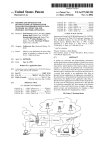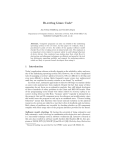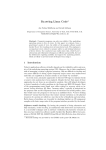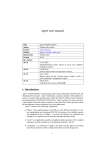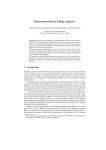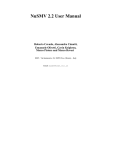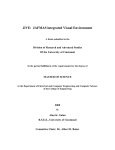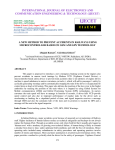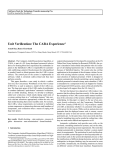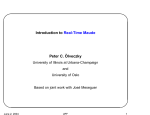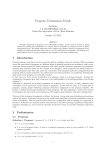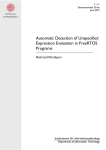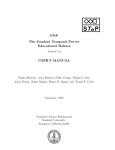Download ANSI-C Bounded Model Checker User Manual
Transcript
ANSI-C Bounded Model Checker
User Manual
Edmund Clarke
Daniel Kroening
August 2, 2006
School of Computer Science
Carnegie Mellon University
Pittsburgh, PA 15213
Abstract
We describe a tool that formally verifies ANSI-C programs. The tool implements a
technique called Bounded Model Checking (BMC). In BMC, the transition relation for
a complex state machine and its specification are jointly unwound to obtain a Boolean
formula, which is then checked for satisfiability by using a SAT procedure. The tool
supports all ANSI-C integer operators and all pointer constructs allowed by the ANSIC standard, including dynamic memory allocation, pointer arithmetic, and pointer type
casts.
This research was sponsored by the Semiconductor Research Corporation (SRC) under contract no. 99-TJ-684, the National Science Foundation (NSF) under grant no. CCR-9803774,
the Office of Naval Research (ONR), the Naval Research Laboratory (NRL) under contract no.
N00014-01-1-0796, and by the Defense Advanced Research Projects Agency and the Army Research Office (ARO) under contract no. DAAD19-01-1-0485.
The views and conclusions contained in this document are those of the author and should
not be interpreted as representing the official policies, either expressed or implied, of SRC, NSF,
ONR, NRL, DOD, ARO, or the U.S. government.
Keywords: ANSI-C, Bounded Model Checking, Pointers
Chapter 1
Introduction
1.1
Bounded Model Checking for ANSI-C
Many safety-critical software systems are legacy designs, i.e., written in a low level
language such as ANSI-C or even assembly language, or at least contain components
that are written in this manner. Very often performance requirements enforce the use of
these languages. These systems are a bigger security and safety problem than programs
written in high level languages.
The verification of low level ANSI-C code is challenging due to extensive use of
arithmetic, pointers and pointer arithmetic, and bit-wise operators.
We describe a tool that formally verifies ANSI-C programs. The properties checked
include pointer safety and array bounds, and user-provided assertions. The tool implements a technique called Bounded Model Checking (BMC). In BMC, the transition
relation for a complex state machine and its specification are jointly unwound to obtain
a Boolean formula, which is then checked for satisfiability by using a SAT procedure.
If the formula is satisfiable, a counterexample is extracted from the output of the SAT
procedure. If the formula is not satisfiable, the program can be unwound more to determine if a longer counterexample exists. The tool checks that sufficient unwinding is
done to ensure that no longer counterexample can exist by means of unwinding assertions.
While one feature of the tool is to check conformance of the program with the
ANSI-C standard [1], many architecture specific extensions of C are supported if enabled by the user. As example, CBMC supports both little-endian and big-endian machine word layouts.
1.2
1.2.1
A Short Tutorial
First Steps
Like a compiler, CBMC takes the name of .c files on the command line. CBMC then
translates the program and merges the function definitions from the various .c files,
1
just like a linker. However, instead of producing a binary for execution, CBMC performs
symbolic simulation on the program.
As an example, consider the following simple program, named file1.c:
int puts(const char *s) { }
int main(int argc, char **argv) {
int i;
if(argc>=1)
puts(argv[2]);
}
Of course, this program is faulty, as the argv array might have only two elements
(argv[0] followed by NULL), and then the array access argv[2] is out of bounds.
Now, run CBMC as follows:
cbmc --show-vcc file1.c
CBMC prints the verification conditions it generates for the program, formatted as a
Gentzen sequent. Note that it prints a comment together with each sequent, in this case
”array argv upper bound” together with the location of the faulty array access. CBMC
prints the equation since the built-in simplifier is not able to determine its validity.
Now run CBMC without the --show-vcc option, which invokes a decision procedure
to solve the formula:
cbmc file1.c
CBMC transforms the equation you have seen before into CNF and passes it to a
SAT solver. It can now detect that the equation is actually not valid, and thus, there is
a bug in the program. It prints a counterexample trace, i.e., a program trace that ends
in a state which violates the property. In case of the example, it ends in the faulty array
access. It also shows the values the input variables must have for the bug to occur. In
this example, argc must be one or larger to trigger the out-of-bounds array access. If
you change the condition in the example to argc>=2, the bug is fixed and CBMC will
report a successful verification run.
1.2.2
Verifying Modules
In the example above, we used a program that starts with a main function. However,
CBMC is aimed at embedded software, and these kinds of programs usually have different entry points. Furthermore, CBMC is also useful for verifying program modules.
Consider the following example, called file2.c:
int array[10];
int sum() {
unsigned i, sum;
sum=0;
2
for(i=0; i<10; i++)
sum+=array[i];
}
In order to set the entry point to the sum function, run
cbmc file2.c --function sum
Note that global variables are initialized before the execution of the given function,
which might result in a state that is different from the state the function is called within
the program itself. Also, note that CBMC does not attempt to guess pre-conditions for
the arguments of the function.
1.2.3
Loop Unwinding
You will note that CBMC unwinds the for loops in the program. As CBMC performs
Bounded Model Checking, all loops have to have a finite upper run-time bound in order
to guarantee that all bugs are found. CBMC actually checks that enough unwinding is
performed. As an example, consider binsearch.c:
int binsearch(int x) {
int a[16];
signed low=0, high=16;
while(low<high) {
signed middle=low+((high-low)>>1);
if(a[middle]<x)
high=middle;
else if(a[middle]>x)
low=middle+1;
else // a[middle]=x !
return middle;
}
return -1;
}
If you run CBMC on this function, you will notice that the unwinding does not stop.
The built-in simplifier is not able to determine a run time bound for this loop. The
unwinding bound has to be given as a command line argument:
cbmc binsearch.c --function binsearch --unwind 6 --decide
CBMC not only verifies the array bounds (note that this actually depends on the
result of the right shift), but also checks that enough unwinding is done, i.e., it proves
a run-time bound. For any lower unwinding bound, there are traces that require more
loop iterations. Thus, CBMC will produce an appropriate counterexample.
3
1.2.4
Unbounded Loops
However, CBMC can also be used for programs with unbounded loops. In this case,
CBMC is used for bug hunting only; CBMC does not attempt to find all bugs. Consider
the following program:
_Bool nondet_bool();
_Bool LOCK = 0;
_Bool lock() {
if(nondet_bool()) {
assert(!LOCK);
LOCK=1;
return 1; }
return 0;
}
void unlock() {
assert(LOCK);
LOCK=0;
}
int main() {
unsigned got_lock = 0;
int times;
while(times > 0) {
if(lock()) {
got_lock++;
/* critical section */
}
if(got_lock!=0)
unlock();
got_lock--;
times--;
}
}
The while loop in the main function has no (useful) run-time bound. Thus, the
–unwind parameter has to be used in order to prevent infinite unwinding. However,
you will note that CBMC will detect that not enough unwinding is done and aborts with
an unwinding assertion violation.
In order to disable this test, run CBMC with the following option:
--no-unwinding-assertions
For an unwinding bound of one, no bug is found. However, already for a bound of two,
CBMC detects a trace that violates an assertion. Without unwinding assertions, CBMC
does not prove the program correct, but it can be helpful to find program bugs.
4
1.2.5
A Note About the ANSI-C Library
The ANSI-C library that comes with any C compiler may not be usable for CBMC.
It usually comes as binary and not as source code, and furthermore, usually contains
architecture dependent code. In case of the GNU C Library, even the prototypes in the
.h file contain code that is not compliant with the ANSI-C standard. CBMC ships with
prototypes that are standard compliant. You need to define this path as include path for
the ANSI-C pre-processor.
E.g., assuming the bash shell is used and gcc is the pre-processor, this statement
adjusts the path accordingly:
export C_INCLUDE_PATH=/path-to-cprover/examples/ansi-c-lib/
This directory only contains the prototypes, no implementation of the library functions is currently provided.
1.3
Outline
In chapter 2, we describe the ANSI-C language features supported by CBMC. In chapter
3, we describe how CBMC can be used to check conformance of hardware designs with
an ANSI-C specification. Chapter 4 describes the command line interface.
1.4
Further Reading
The first version of CBMC was introduced in [2] in the context of equivalence checking.
Improved versions are described in [3] and [4].
5
Chapter 2
ANSI-C Language Features
2.1
Basic Datatypes
CBMC supports the scalar data types as defined by the ANSI-C standard, including
Bool. By default int is 32 bits wide, short int is 16 bits wide, and char
is 8 bits wide. Using a command line option, these default widths can be changed.
By default, char is signed. Since some architectures use an unsigned char type, a
command line option allows to change this setting.
There is also support for the floating point data types float, double, and long
double. By default, CBMC uses fixed-point arithmetic for these types. Variables
of type float have by default 32 bits (16 bits integer part, 16 bits fractional part),
variables of type double and long double have 64 bits.
In addition to the types defined by the ANSI-C standard, CBMC supports the following Microsoft C extensions: int8, int16, int32, int64. These types
define a bit vector with the given number of bits.
2.2
2.2.1
Operators
Boolean Operators
CBMC supports all ANSI-C Boolean operators on scalar variables a, b:
Operator
!a
a && b
a || b
2.2.2
Description
negation
and
or
Integer Arithmetic Operators
CBMC supports all integer arithmetic operators on scalar variables a, b:
6
Operator
-a
a+b
a-b
a*b
a/b
a%b
a<<b
a>>b
a&b
a|b
aˆb
a< b
a<=b
a> b
a>=b
Description
unary minus, negation
sum
subtraction
multiplication
division
remainder
bit-wise left shift
bit-wise right shift
bit-wise and
bit-wise or
bit-wise xor
relation
relation
relation
relation
Note that the multiplication, division, and reminder operators are very expensive
with respect to the size of the equation that is passed to the SAT solver. Furthermore,
the equations are hard to solve for all SAT solvers known to us.
As an example, consider the following program:
unsigned char nondet_uchar();
int main() {
unsigned char a, b;
unsigned int result=0, i;
a=nondet_uchar();
b=nondet_uchar();
for(i=0; i<8; i++)
if((b>>i)&1)
result+=(a<<i);
assert(result==a*b);
}
The program non-deterministically selects two 8-bit unsigned values, and then uses
shift-and-add to multiply them. It then asserts that the result (i.e., the sum) matches
a*b. Although the resulting SAT instance has only about 2400 variables, it takes
about 3 minutes to solve using MiniSAT.
Properties Checked Optionally, CBMC allows checking for arithmetic overflow in
case of signed operands. In case of the division and the remainder operator, CBMC
checks for division by zero. This check can be disabled using a command line option.
7
As an example, the following program non-deterministically selects two unsigned
integers a and b. It then checks that either of them is non-zero and then computes the
inverse of a+b:
int main() {
unsigned int a, b, c;
a=nondet_uint();
b=nondet_uint();
if(a>0 || b>0)
c=1/(a+b);
}
However, due to arithmetic overflow when computing the sum, the division can
turn out to be a division by zero. CBMC generates a counterexample as follows for the
program above:
Initial State
---------------------------------------------------c=0 (00000000000000000000000000000000)
State 1 file div_by_zero.c line 4 function main
---------------------------------------------------a=4294967295 (11111111111111111111111111111111)
State 2 file div_by_zero.c line 5 function main
---------------------------------------------------b=1 (00000000000000000000000000000001)
Failed assertion: division by zero file div_by_zero.c
line 8 function main
2.2.3
Floating Point Arithmetic Operators
CBMC supports the following operators on variables of the types float, double, and
long double:
Operator
-a
a+b
a-b
a*b
a< b
a<=b
a> b
a>=b
Description
unary minus, negation
sum
subtraction
multiplication
relation
relation
relation
relation
Division is currently not supported. Note that the multiplication operator is very
expensive with respect to the size of the equation that is passed to the SAT solver.
Furthermore, the equations are hard to solve for all SAT solvers known to us. CBMC
also supports type conversions to and from integer types.
8
2.2.4
The Comma Operator
CBMC supports the comma operator a, b. The operands are evaluated for potential
side effects. The result of the operator is the right operand.
2.2.5
Type Casts
CBMC has full support for arithmetic type casts. As an example, the expression
(unsigned char)i
for an integer i is guaranteed to be between 0 and 255 in case of an eight bit character
type.
Properties Checked For the unsigned data types, the ANSI-C standard requires
modulo semantics, i.e., that no overflow exception occurs. Thus, overflow is not
checked. For signed data types, an overflow exception is permitted. Optionally, CBMC
checks for such arithmetic overflows.
2.2.6
Side Effects
CBMC allows all side effect operators with their respective semantics. This includes
the assignment operators (=, +=, etc.), and the pre- and post- increment and decrement
operators.
As an example, consider the following program fragment:
unsigned int i, j;
i=j++;
After the execution of the program, the variable i will contain the initial value of
j, and j will contain the initial value of j plus one. CBMC generates the following
equation from the program:
i1
j1
= j0
= j0 + 1
CBMC performs the implicit type cast as required by the ANSI-C standard. As an
example, consider the following program fragment:
char c;
int i;
long l;
l = c = i;
The value of i is converted to the type of the assignment expression c=i, that is,
char type. The value of this expression is then converted to the type of the outer
assignment expression, that is, long int type.
9
Ordering of Evaluation The ANSI-C standard allows arbitrary orderings for the
evaluations of expressions and the time the side-effect becomes visible. The only exceptions are the operators &&, ||, and the trinary operator ?:. For the Boolean operators, the standard requires strict evaluation from left to right, and that the evaluation
aborts once the result is known. The operands of the expression c ? x : y must
be evaluated as follows: first, c is evaluated. If c is true, x is evaluated, and y otherwise.
As an example, assume that a pointer p in the following fragment may point to
either NULL or a valid, active object. Then, an if statement as follows is valid, since
the evaluation must be done from left to right, and if p points to NULL, the result of the
Boolean AND is known to be false and the evaluation aborts before p is dereferenced.
if(p!=NULL && *p==5) {
. . .
For other operators, such as addition, no such fixed ordering exists. As an example,
consider the following fragment:
int g;
int f() {
g=1;
...
}
...
g=2;
if(f()+g==1) {
...
In this fragment, a global variable g is assigned to by a function f(), and just before
an if statement. Furthermore, g is used in an addition expression in the condition of
the if statement together with a call to f(). If f() is evaluated first, the value of
g in the sum will be one, while it is two if g is evaluated first. The actual result is
architecture dependent.
Properties Checked CBMC models this problem as follows: One option allows setting a fixed ordering of evaluation for all operators. The other option allows checking
for such artifacts: CBMC asserts that no side-effect affects the value of any variable
that is evaluated with equal priority. This includes changes made indirectly by means
of pointers. In the example, this is realized by write-protecting the variable g during
the execution of f. This rules out programs that show architecture dependent behavior
due to the ordering of evaluation. While such programs are still valid ANSI-C programs, we do not believe that programs showing architecture dependent behavior are
desirable.
10
2.2.7
Function calls
CBMC supports functions by inlining. No modular approach is done. CBMC preserves
the locality of the parameters and the non-static local variables by renaming.
As an example, the following program calls the functions f() and g() twice.
While f() uses a static variable, which is not renamed between calls, g() uses a true
local variable, which gets a new value for each call.
int f() {
static int s=0;
s++;
return s;
}
int g() {
int l=0;
l++;
return l;
}
int main() {
assert(f()==1);
assert(f()==2);
assert(g()==1);
assert(g()==1);
}
//
//
//
//
first call to f
second call to f
first call to g
second call to g
Recursion is implemented by finite unwinding, as done for while loops. CBMC
checks that enough unwinding is done by means of an unwinding assertion (section
2.3.6 provides more details).
2.3
2.3.1
Control Flow Statements
Conditional Statement
CBMC allows the use of the conditional statement as described in the ANSI-C standard.
Properties Checked CBMC generates a warning if the assignment operator is used as
condition of a control flow statement such as if or while.
2.3.2 return
The return statement without value is transformed into an equivalent goto statement. The target is the end of the function. The return statement with value is
11
transformed into an assignment of the value returned and the goto statement to the
end of the function.
Properties Checked CBMC enforces that functions with a non-void return type return
a value by means of the return statement. The execution of the function must not end
by reaching the end of the function. This is realized by inserting assert(FALSE);
at the end of the function. CBMC reports an error trace if this location is reachable.
As an example, consider the following fragment:
int f() {
int c=nondet_int();
if(c!=1)
return c;
}
int main() {
int i;
i=f();
}
In this fragment, f() may exit without returning a value. CBMC produces the
following counterexample:
State 1 file no-return.c line 2 function f
---------------------------------------------------c=1 (00000000000000000000000000000001)
Failed assertion: end-of-function assertion
file no-return.c line 6 function f
2.3.3 goto
While only few C programs make use of goto statements, CBMC provides support
for such programs. We distinguish forward and backward jumps. In case of backward
jumps, the same technique used for loops is applied: the loop is unwound a given
number of times, and then we check that this number of times is sufficient by replacing
the goto statement by assert(FALSE);.
2.3.4 break and continue
The break and continue statements are replaced by equivalent goto statements
as described in the ANSI-C standard.
2.3.5 switch
CBMC provides full support for switch statements, including ”fall-through”, as in the
following example:
12
switch(i) {
case 1: j++;
case 2: j++; break;
}
2.3.6
Loops
In Bounded Model Checking, the transition system is unwound up to a finite depth.
In case of C programs, this means that for and while are unwound up to a certain
depth. In many cases, CBMC is able to automatically detect the maximum number of
times a loop can be executed. This includes while loops and loops with modifications
to the loop counter inside the loop body, even when done indirectly using a pointer.
However, in case of loops that have no pre-set bound, e.g., loops iterating on dynamic data structures, the user must specify a bound by means of the --unwind
command line argument. CBMC will then unwind the loops up to that bound and check
that the number is large enough by means of an unwinding assertion.
2.4
Non-Determinism
CBMC allows to model user-input by means of non-deterministic choice functions. The
names of these functions have the prefix nondet . The value range generated is determined by the return type of the function. As an example,
int nondet_int();
returns a non-deterministically chosen value of type int. The functions are built-in,
i.e., the prototype is sufficient. CBMC will evaluate all traces arising from all possible
choices.
2.5
Assumptions and Assertions
CBMC checks assertions as defined by the ANSI-C standard: The assert statement
takes a Boolean condition, and CBMC checks that this condition is true for all runs of
the program. The logic for assertions is the usual ANSI-C expression logic.
In addition to the assert statement, CBMC provides the CPROVER assume
statement. The CPROVER assume statement restricts the program traces that are
considered and allows assume-guarantee reasoning. As an assertion, an assumption
takes a Boolean expression. Intuitively, one can consider the CPROVER assume
statement to abort the program successfully if the condition is false. If the condition is
true, the execution continues.
As an example, the following function first non-deterministically picks an integer
value. It then assumes that the integer is in a specific range and returns the value.
int one_to_ten() {
int value=nondet_int();
__CPROVER_assume(value>=1 && value<=10);
13
return value;
}
Note that the assume statement is not retro-active with respect to assertions. E.g.,
assert(value<10);
__CPROVER_assume(value==0);
may fail, while
__CPROVER_assume(value==0);
assert(value<10);
passes.
When using the CPROVER assume statement, it must be ensured that there still
exists a program trace that satisfies the condition. Otherwise, any property will pass
vacuously. This should be checked by replacing the property by false. If no counterexample is produced, the assumptions eliminate all program paths.
2.6
Arrays
CBMC allows arrays as defined by the ANSI-C standard. This includes multi-dimensional
arrays and dynamically-sized arrays.
Dynamic Arrays The ANSI-C standard allows arrays with non-constant size as long
as the array does not have static storage duration, i.e., is a non-static local variable.
Even though such a construct has a potentially huge state space, CBMC provides full
support for arrays with non-constant size. The size of the Boolean equation that is
generated does not depend on the array size, but rather on the number of read or write
accesses to the array.
Properties Checked CBMC checks both lower and upper bound of arrays, even for
arrays with dynamic size. As an example, consider the following fragment:
unsigned size=nondet_uint();
char a[size];
a[10]=0;
In this fragment, an array a is defined, which has a non-deterministically chosen
size. The code then accesses the array element with index 10. CBMC produces a counterexample with an upper array bound error on array a. The trace shows a value for
size less then 10.
Furthermore, CBMC checks that the size of arrays with dynamic size is non-negative.
As an example, consider the following fragment:
14
signed size=nondet_int();
char a[size];
For this fragment, CBMC produces a counterexample in which the size of the array
a is negative.
2.7
Structures
CBMC allows arbitrary structure types. The structures may be nested, and may contain
arrays.
The sizeof operator applied to a structure type yields the sum of the sizes of
the components. However, the ANSI-C standard allows arbitrary padding between
components. In order to reflect this padding, the sizeof operator should return the
sum of the sizes of the components plus a non-deterministically chosen non-negative
value.
Recursive Structures Structures may be recursive by means of pointers to the same
structure. As an example, consider the following fragment:
struct nodet {
struct nodet *n;
int payload;
};
int main() {
unsigned i;
struct nodet *list=(void *)0;
struct nodet *new_node;
for(i=0; i<10; i++) {
new_node=malloc(sizeof(*new_node));
new_node->n=list;
list=new_node;
}
}
The fragment builds a linked list with ten dynamically allocated elements.
Structures with Dynamic Array The last component of an ANSI-C structure may
be an incomplete array (an array without size). This incomplete array is used for dynamic allocation. This is described in section 2.10.
2.8
Unions
CBMC allows the use of unions to use the same storage for multiple data types. Internally, CBMC actually shares the literals used to represent the variables values among
15
the union members.
Properties Checked CBMC does not permit the use of unions for type conversion, as
this would result in architecture dependent behavior. Specifically, if a member is read,
the same member must have been used for writing to the union the last time.
2.9
2.9.1
Pointers
The Pointer Data Type
Pointers are commonly used in ANSI-C programs. In particular, pointers are required
for call by reference and for dynamic data structures. CBMC provides extensive support
for programs that use pointers according to rules set by the ANSI-C standard, including
pointer type casts and pointer arithmetic.
The size of a pointer, e.g., sizeof(void *) is by default 4 bytes. This can be
adjusted using a command line option.
Conversion of pointers from and to integers The ANSI-C standard does not provide any guarantees for the conversion of pointers into integers. However, CBMC ensures that the conversion of the same address into an integer yields the same integer.
The ANSI-C standard does not guarantee that the conversion of a pointer into an integer
and then back yields a valid pointer. CBMC does not allow this construct.
2.9.2
Pointer Arithmetic
CBMC supports the ANSI-C pointer arithmetic operators. As an example, consider the
following fragment:
int array[10], *p;
int main() {
array[1] = 1;
p = &array[0];
p++;
assert(*p == 1);
}
2.9.3
The Relational Operators on Pointers
The ANSI-C standard allows comparing to pointers using the relational operators <=,
<, >=, <.
Properties Checked The standard restricts the use of these operators to pointers that
point to the same object. CBMC enforces this restriction by means of an automatically
generated assertion.
16
2.9.4
Pointer Type Casts
CBMC provides full support for pointer type casts as described by the ANSI-C standard.
As an example, it is a common practice to convert a pointer to, e.g., an integer into a
pointer to void and then back:
int i;
void *p;
p=&i;
. . .
*((int *)p)=5;
Note that pointer type casts are frequently used for architecture specific type conversions, e.g., to write an integer byte-wise into a file or to send it over a socket:
int i;
char *p;
p=(char *)&i;
for(j=0; j<4; j++) {
/* write *p */
p++;
}
The result is architecture-dependent. In particular, it exposes the endianess of the architecture. CBMC allows these constructs if the endianess is specified on the command
line with one of the following two options:
--little-endian
--big-endian
Properties Checked CBMC checks that the type of the object being accessed matches
the type of the dereferencing expression. For example, the following fragment uses a
void * pointer to store the addresses of both char and int type objects:
int nondet_int();
void *p;
int i;
char c;
int main() {
int input1, input2, z;
input1=nondet_int();
input2=nondet_int();
p=input1? (void *)&i : (void *)&c;
17
if(input2)
z=*(int *)p;
else
z=*(char *)p;
}
CBMC produces the following counterexample:
Initial State
---------------------------------------------------c=0 (00000000)
i=0 (00000000000000000000000000000000)
p=NULL
State 1 file line 10 function main
---------------------------------------------------input1=0 (00000000000000000000000000000000)
State 2 file line 11 function main
---------------------------------------------------input2=1 (00000000000000000000000000000001)
State 3 line 13 function main
---------------------------------------------------p=&c
Failed assertion: dereference failure (wrong object type)
line 16 function main
Note that the ANSI-C standard allows the conversion of pointers to structures to
another pointer to a prefix of the same structure. As an example, the following program
performs a valid pointer conversion:
typedef struct {
int i;
char j;
} s;
typedef struct {
int i;
} prefix;
int main() {
s x;
prefix *p;
p=(prefix *)&x;
p->i=1;
}
18
2.9.5
String Constants
ANSI-C implements strings of characters as an array. Strings are then often represented
by means of a pointer pointing to the array. Array bounds violations of string arrays are
the leading cause of security holes in Internet software such as servers or web browsers.
CBMC provides full support for string constants, usable either in initializers or as
a constant. As an example, the following fragment contains a string array s, which is
initialized using a string constant. Then, a pointer p is initialized with the address of s,
and the second character of s is modified indirectly by dereferencing p. The program
then asserts this change to s.
char s[]="abc";
int main() {
char *p=s;
/* write to p[1] */
p[1]=’y’;
assert(s[1]==’y’);
}
Properties Checked CBMC performs bounds checking for string constants as well as
for normal arrays. In the following fragment, a pointer p is pointing to a string constant
of length three. Then, an input i is used as address of an array index operation. CBMC
asserts that the input i is not greater than four (the string constant ends with an implicit
zero character).
char *p="abc";
void f(unsigned int i) {
char ch;
/* results in bounds violation with i>4 */
ch=p[i];
}
In addition to that, CBMC checks that string constants are never written into by
means of pointers pointing to them.
2.9.6
Pointers to Functions
CBMC allows pointers to functions, and calls through such a pointer. The function
pointed to may depend on non-deterministically chosen inputs. As an example, the
following fragment contains a table of three function pointers. The program uses a
function argument to index the table and then calls the function. It then asserts that the
right function was called.
19
int global;
int f() { global=0; }
int g() { global=1; }
int h() { global=2; }
typedef int (*fptr)();
fptr table[] = { f, g, h };
void select(unsigned x) {
if(x<=2) {
table[x]();
assert(global==x);
}
}
2.10
Dynamic Memory
CBMC allows programs that make use of dynamic memory allocation, e.g., for dynamically sized arrays or data structures such as lists or graphs. As an example, the
following fragment allocates a variable number of integers using malloc, writes one
value into the last array element, and then deallocates the array:
void f(unsigned int n) {
int *p;
p=malloc(sizeof(int)*n);
p[n-1]=0;
free(p);
}
Properties Checked Optionally, CBMC checks array bounds of dynamically allocated arrays, and it checks that a pointer pointing to a dynamic object is pointing to an
active object (i.e., that the object has not yet been freed and that it is not a static object).
Furthermore, CBMC checks that an object is not freed more than once.
In addition to that, CBMC can check that all dynamically allocated memory is deallocated before exiting the program, i.e., CBMC can prove the absence of ”memory
leaks”.
As an example, the following fragment dynamically allocates memory, and stores
the address of that memory in a pointer p. Depending on an input i, this pointer is
redirected to a local variable y. The memory pointed to by p is then deallocated using
free. CBMC detects that there is an illegal execution trace in case that the input i is
true.
void f(_Bool i) {
int *p;
20
int y;
p=malloc(sizeof(int)*10);
if(i) p=&y;
/* error if p points to y */
free(p);
}
21
Chapter 3
Hardware Verification using
ANSI-C as a Reference
3.1
Introduction
A common hardware design approach employed by many companies is to first write
a quick prototype that behaves like the planned circuit in a language like ANSI-C.
This program is then used for extensive testing and debugging, in particular of any
embedded software that is later on shipped with the circuit. An example is the hardware
of a cell phone and its software. After testing and debugging of the program, the
actual hardware design is written using hardware description languages like VHDL or
Verilog.
Thus, there are two implementations of the same design: one written in ANSI-C,
which is written for simulation, and one written in register transfer level HDL, which
is the actual product. The ANSI-C implementation is usually thoroughly tested and
debugged.
Due to market constraints, companies aim to sell the chip as soon as possible,
i.e., shortly after the HDL implementation is designed. There is usually little time for
additional debugging and testing of the HDL implementation. Thus, an automated, or
nearly automated way of establishing the consistency of the HDL implementation is
highly desirable.
This motivates the verification problem: we want to verify the consistency of the
HDL implementation, i.e., the product, using the ANSI-C implementation as a reference [5]. Establishing the consistency does not require a formal specification. However, formal methods to verify either the hardware or software design are still desirable.
Related Work There have been several attempts in the past to tackle the problem.
In [6], a tool for verifying the combinational equivalence of RTL-C and an HDL is
described. They translate the C code into HDL and use standard equivalence checkers
to establish the equivalence. The C code has to be very close to a hardware description
(RTL level), which implies that the source and target have to be implemented in a very
22
similar way. There are also variants of C specifically for this purpose. The System C
standard defines a subset of C++ that can be used for synthesis [7]. Other variants of
ANSI-C for specifying hardware are Spec C and Handel C, among others.
The concept of verifying the equivalence of a software implementation and a synchronous transition system was introduced by Pnueli, Siegel, and Shtrichman [8]. The
C program is required to be in a very specific form, since a mechanical translation is
assumed.
In [9], Currie, Hu, and Rajan transform DSP assembly language into an equation
for the Stanford Validity Checker. However, problems involving bit vector overflow are
not detected and while loops are not supported. The symbolic execution of programs
for comparison with RTL is common practice [10, 11].
The previous work focuses on a small subset of ANSI-C that is particularly close to
register transfer language. Thus, the designer is often required to rewrite the C program
manually in order to comply with these constraints. We extend the methodology to
handle the full set of ANSI-C language features. This is a challenge in the presence of
complex, dynamic data structures and pointers that may dynamically point to multiple
objects. Furthermore, our methodology allows arbitrary loop constructs.
3.2
A small Tutorial
The following Verilog module implements a 4-bit counter:
module main(clk);
input clk;
reg [3:0] counter;
initial counter=0;
always @(posedge clk)
counter=counter+1;
endmodule
CBMC can take Verilog modules as the one above as additional input. The trace
produced by the Verilog module is provided to the C program by means of arrays.
For the example above, the following C fragment is the declaration of the array that
corresponds to the trace values of the counter register:
extern const unsigned int counter[];
Note that the array has no size specification. However, as CBMC performs Bounded
Model Checking, the size of the array must be bounded. As it is desirable to change
the bound to adjust it to the available computing capacity, the bound is given on the
command line and not as part of the C program. This makes it easy to use only one C
program for arbitrary bounds. The actual bound is available in the C program using the
following declaration:
23
extern const unsigned int bound;
Also note that the array declaration above declares an array with constant members.
Thus, the C program can only read the trace values and not modify them. We later on
describe how to drive inputs of the Verilog module within the C program.
As described in previous chapters, assertions can be used to verify properties of the
Verilog trace. As an example, the following program checks two values of the trace of
the counter module:
extern const unsigned int bound;
extern const unsigned int counter[];
int main() {
assert(counter[5]==5);
assert(counter[16]==0);
}
The following CBMC command line checks these assertions with a bound of 20:
hw-cbmc counter.c counter.v --module main --bound 20 --decide
Note that hw-cbmc must be used instead of cbmc. The module name given must
match the name of the top module in the Verilog file. Multiple Verilog files can be
given on the command line.
The --bound parameter is not to be confused with the --unwind parameter.
While the --unwind parameter specifies the maximum unwinding depth for loops
within the C program, the --bound parameter specifies the number of times the transition relation of the Verilog module is to be unwound.
Counterexamples For the given example, the verification is successful. If the first
assertion is changed to
assert(counter[5]==0);
and the bound on the command line is changed to 6, CBMC produces a counterexample.
CBMC produces two traces: One for the C program, which matches the traces described
earlier, and a separate trace for the Verilog module. The values of the registers in the
Verilog module are also shown in the C trace as part of the initial state.
Initial State
---------------------------------------------------bound=6 (00000000000000000000000000000110)
counter= 0, 1, 2, 3, 4, 5, 6
Failed assertion: assertion line 6 function main
Transition system state 0
---------------------------------------------------counter=0 (0000)
Transition system state 1
----------------------------------------------------
24
counter=1 (0001)
Transition system state 2
---------------------------------------------------counter=2 (0010)
Transition system state 3
---------------------------------------------------counter=3 (0011)
Transition system state 4
---------------------------------------------------counter=4 (0100)
Transition system state 5
---------------------------------------------------counter=5 (0101)
Transition system state 6
---------------------------------------------------counter=6 (0110)
Using the Bound The following program is using the bound variable to check the
counter value in all cycles:
extern const unsigned int bound;
extern const unsigned int counter[];
int main() {
unsigned cycle;
for(cycle=0; cycle<=bound; cycle++)
assert(counter[cycle]==(cycle & 15));
}
CBMC performs array bounds checking on the trace arrays. Thus, care must be
taken to prevent access to the trace arrays beyond the bound.
Synchronizing Inputs The example above is trivial as there is only one possible
trace. The initial state is deterministic, and there is only one possible transition, so the
verification problem can be solved by mere testing. Consider the following Verilog
module:
module main(clk, i);
input clk;
input i;
reg [3:0] counter;
initial counter=0;
always @(posedge clk)
25
if(i)
counter=counter+1;
endmodule
Using the C program above fails, as the Verilog module is free to use zero as value
for the input i. This implies that the counter is not incremented. The C program has to
read the value of the input i in order to be able to get the correct counter value:
extern const unsigned int bound;
extern const unsigned int counter[];
extern const unsigned _Bool i[];
int main() {
unsigned cycle;
unsigned C_counter=0;
for(cycle=0; cycle<=bound; cycle++) {
assert(counter[cycle]==(C_counter & 15));
if(i[cycle]) C_counter++;
}
}
Similarly, the C model has to synchronize on the choice of the initial value of
registers if the Verilog module does not perform initialization.
Restricting the Choice of Inputs The C program can also restrict the choice of inputs of the Verilog module. This is useful for adding environment constraints. As an
example, consider a Verilog module that has a signal reset as an input, which is
active-low. The following C fragment drives this input to be active in the first cycle,
and not active in any subsequent cycle:
assume(resetn[0]==0);
for(i=1; i<=bound; i++)
__CPROVER_assume(resetn[i]);
Mapping Variables within the Module Hierarchy Verilog modules are hierarchical. The extern declarations shown above only allow reading the values of signals
and registers that are in the top module. In order to read values from sub-modules,
CBMC uses structures.
As an example, consider the following Verilog file:
module counter(clk, increment);
input clk;
input [7:0] increment;
reg [7:0] counter;
26
initial counter=0;
always @(posedge clk)
counter=counter+increment;
endmodule
module main(clk);
input clk;
counter c1(clk, 1);
counter c2(clk, 2);
endmodule
The file has two modules: a main module and a counter module. The counter module is instantiated twice within the main module. A reference to the register counter
within the C program would be ambiguous, as the two module instances have separate
instances of the register. CBMC uses the following data structures for this example:
/* unwinding bound */
extern const unsigned int bound;
/*
Module verilog::main
*/
extern const _Bool
clk[];
/*
Module verilog::counter
*/
struct counter {
_Bool
clk;
unsigned char increment;
unsigned char counter;
};
extern const struct counter c1[];
extern const struct counter c2[];
int main() {
assert(c1[5].counter==5);
assert(c2[5].counter==10);
}
The main function reads both counter values for cycle 5. A deeper hierarchy (modules in modules) is realized by using structure members. Writing these data structures
27
for large Verilog designs is error prone, and thus, CBMC can automatically generate
them. The declarations above are generated using the command line
cbmc --gen-interface --module main hierarchy.v
Mapping Verilog Vectors to Arrays or Scalars In Verilog, a definition such as
wire [31:0] x;
can be used for arithmetic (e.g., x+10) and as array of Booleans (e.g., x[2]). ANSIC does not allow both, so when mapping variables from Verilog to C, the user has to
choose one option for each such variable. As an example, the C declaration
extern const unsigned int x[];
allows using x in arithmetic expressions, while the C declaration
extern const _Bool x[][32];
allows accessing the individual bits of x using the syntax x[cycle][bit]. The
--gen-interface option of CBMC generates the first variant if the vector has the
same size as one of the standard integer types, and the second option if not so. This
choice can be changed by adjusting the declaration accordingly.
28
Chapter 4
Command Line Interface
This chapter describes the command line interface of CBMC. Like a C compiler, CBMC
takes the names of the .c source files as arguments. Additional options allow to customize the behavior of CBMC.
Description
only show program expression
set main function name
do not simplify
keep all claims
unwind nr times
unwind given loop nr times
only show claims
run decision procedure
generate CNF in DIMACS format
generate subgoals documentation
remove unrelated assignments
do not perform substitution
do not simplify ?:
ignore assertions
do not generate unwinding assertions
do not do array bounds check
do not do division by zero check
do not do pointer check
number of transitions
module to unwind
write counterexample to file
Option
--program-only
--function name
--no-simplify
--all-claims
--unwind nr
--unwindset nr
--claims-only
--decide
--dimacs
--document-subgoals
--remove-assignments
--no-substitution
--no-simplify-if
--no-assertions
--no-unwinding-assertions
--no-bounds-check
--no-div-by-zero-check
--no-pointer-check
--bound nr
--module name
--counterexample file
29
Bibliography
[1] International Organization for Standardization. ISO/IEC 9899:1999: Programming languages — C. International Organization for Standardization, Geneva,
Switzerland, 1999.
[2] Edmund Clarke and Daniel Kroening. Hardware verification using ANSI-C programs as a reference. In Proceedings of ASP-DAC 2003, pages 308–311. IEEE
Computer Society Press, January 2003.
[3] Daniel Kroening, Edmund Clarke, and Karen Yorav. Behavioral consistency of
C and Verilog programs using bounded model checking. In Proceedings of DAC
2003, pages 368–371. ACM Press, 2003.
[4] Edmund Clarke, Daniel Kroening, and Flavio Lerda. A tool for checking ANSI-C
programs. In Kurt Jensen and Andreas Podelski, editors, Tools and Algorithms for
the Construction and Analysis of Systems (TACAS 2004), volume 2988 of Lecture
Notes in Computer Science, pages 168–176. Springer, 2004.
[5] Carl Pixley. Guest Editor’s Introduction: Formal Verification of Commercial
Integrated Circuits. IEEE Design & Test of Computers, 18(4):4–5, 2001.
[6] Luc Séméria, Andrew Seawright, Renu Mehra, Daniel Ng, Arjuna Ekanayake,
and Barry Pangrle. RTL C-based methodology for designing and verifying a
multi-threaded processor. In Proc. of the 39th Design Automation Conference,
pages 123–128. ACM Press, 2002.
[7] http://www.systemc.org.
[8] A. Pnueli, M. Siegel, and O. Shtrichman. The code validation tool (CVT)- automatic verification of a compilation process. Int. Journal of Software Tools for
Technology Transfer (STTT), 2(2):192–201, 1998.
[9] David W. Currie, Alan J. Hu, and Sreeranga Rajan. Automatic formal verification
of DSP software. In Proceedings of the 37th Design Automation Conference
(DAC 2000), pages 130–135. ACM Press, 2000.
[10] Kiyoharu Hamaguchi. Symbolic simulation heuristics for high-level design descriptions with uninterpreted functions. In International Workshop on High-Level
Design, Validation, and Test, pages 25–30. IEEE, 2001.
30
[11] C. Blank, H. Eveking, J. Levihn, and G. Ritter. Symbolic simulation techniques
— state-of-the-art and applications. In International Workshop on High-Level
Design, Validation, and Test, pages 45–50. IEEE, 2001.
31




































